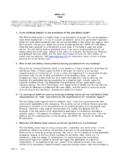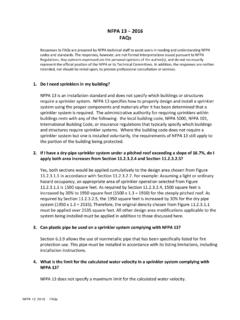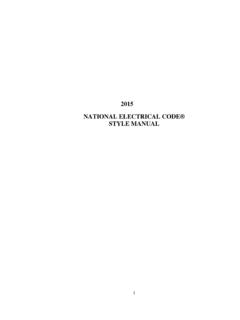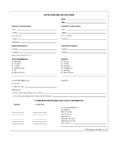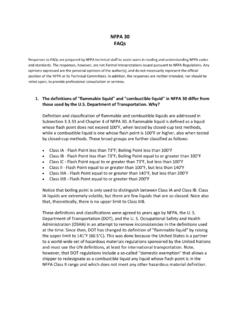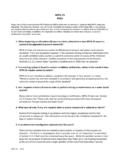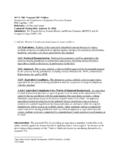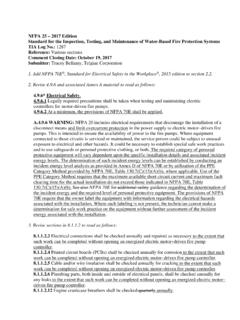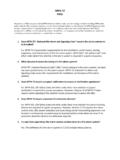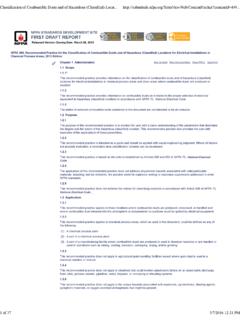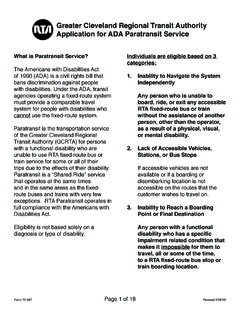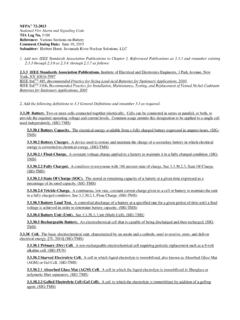Transcription of NFPA 1221-2019 Edition Standard on Installation ...
1 nfpa 1221-2019 Edition Standard on Installation , Maintenance, and Use of Emergency Services Communications Systems TIA Log No.: 1435 Reference: (2)(d), (7), (7), and (7) Comment Closing Date: May 8, 2019 Submitter: Sagiv Weiss-Ishai, San Francisco Fire Department 1. Revise (2)(d) to read as follows: Fire Alarm System. The system shall include automatic supervisory signals for malfunctions of the two-way radio communications enhancement systems that are annunciated by the fire alarm system in accordance with nfpa 72 and shall comply with the following: (1) Monitoring for integrity of the system shall comply with Chapter 10 of nfpa 72. (2) System supervisory signals shall include the following: (a) Donor antenna malfunction (b) Active RF-emitting device failure (c) Low-battery capacity indication when 70 percent of the 12-hour operating capacity has been depleted (d) Active and passive system component failure (3) Power supply supervisory signals shall include the following for each RF-emitting device and active system components: (a) Loss of normal ac power (b) Failure of battery charger (4) The communications link between the fire alarm system and the two-way radio communications enhancement system shall be monitored for integrity.
2 2. Revise (7) to read as follows: A dedicated annunciator shall be provided within the fire command center to annunciate the status of all RF-emitting devices and active system component locations. This device shall provide visual and labeled indications of the following for each system component and RF-emitting device: (1) Normal ac power (2) Loss of normal ac power (3) Battery charger failure (4) Low-battery capacity ( , to 70 percent depletion) (5) Donor antenna malfunction (6) Active RF-emitting device malfunction (7) Active and passive system component malfunction 3. Revise (7) to read as follows: All systems that are connected to fire alarm systems that are not monitored for alarm, supervisory, and trouble conditions off site as defined by nfpa 72 shall be visually inspected weekly for the following conditions: (1) Normal ac power (2) Loss of normal ac power (3) Battery charger failure (4) Low battery capacity (5) Donor antenna malfunction (6) Active RF-emitting device malfunction (7) Active and passive system component malfunction (8) Loss of communication with the fire alarm control panel 4.
3 Revise (7) to read as follows: All systems that are connected to fire alarm systems that are monitored for alarm, supervisory, and trouble conditions off site as defined by nfpa 72 shall be visually inspected semiannually for the following conditions: (1) Normal ac power (2) Loss of normal ac power (3) Battery charger failure (4) Low battery capacity (5) Donor antenna malfunction (6) Active RF-emitting device malfunction (7) Active and passive system component malfunction (8) Loss of communication with the fire alarm control panel (9) Signs of physical damage to components that could affect proper system operation Substantiation: 1. The Two-way Radio Communications Enhancement System (RCES) is ONE of SIX Two-Way Emergency Communications Systems specified in nfpa 72 Section (See section below for reference). All the other 2-WAY ECS specified in this section are required by nfpa 72 to be completely monitored for Integrity (All 2-WAY ECS components must be monitored for integrity).
4 Therefore, the RCES should not have a lesser Standard and lesser integrity and reliability than all other 2-Way ECS specified in nfpa 72. Therefore, the RCES must be completely monitored for integrity including all its Passive and Active components (or ALL system components). There are available and viable technical solutions to perform complete RCES system monitoring (Passive and Active components supervision) and this TIA tries to ensure same level of integrity and reliability for ALL 2-Way ECS. Two-way emergency communications systems shall consist of one or more of the following: (1) Two-way, in-building wired emergency services communications systems (see Section ) (2) Two-way radio communications enhancement systems (see Section ) (3) Area of refuge (area of rescue assistance) emergency communications systems (see Section ) (4) Stairway communications systems (see Section ) (5) Elevator landing communications systems (see Section ) (6) Occupant evacuation elevator lobby communications systems (see Section ) 2.
5 Since the 2016 Edition of 1221 was specifically written to NOT LIMIT any particular approach or technology related to two way RCES monitoring, there was a specific intent to NOT limit the RCES monitoring for ACTIVE components only. Therefore, several equipment manufacturers and companies have already developed viable technical solutions in order to comply with the 2016 Edition of nfpa 1221 (I have attached 5 examples to my TIA proposal) for a complete RCES monitoring including PASSIVE and ACTIVE components. This will make the RCES to have the same level of integrity and reliability as all the other 2-WAY ECS specified in nfpa 72 3. The currently published IFC-2018 Section (6) requires Critical system component monitoring which is a separate input than the Active RF-emitting device mentioned in item (4) of this section. This means that the passive antennas and components could also be considered and interpreted by enforcing agencies as critical system components since without the proper functionality of these passive components, the ERRCS may be malfunction and/or disabled, etc.
6 Therefore, the 2019 Edition of nfpa 1221 creates a potential conflict with the IFC. This is a major conflict between a CODE (IFC) and a Standard ( nfpa 1221-2019 ) and when such conflict exists, the code typically prevails. It is highly important to monitor for integrity all system components of any Life-Safety and Emergency Communications Systems as required by nfpa 72 for Fire Alarm systems and Emergency Communications Systems. If the passive components of an ERRCS will not be required to be monitored for integrity, they may have a malfunction or a failure or may be disconnected from the system for a long time, etc., without anyone being notified about this safety concern and the system inability to provide reliable communication for first responders during fire and non-fire emergencies. If the system malfunction is not monitored, detected and corrected in a timely manner, it may cause a life-safety risk for the responding firefighters and other first responders who may not be able to communicate during fire and non-fire emergencies, due to this system failure.
7 Emergency Nature: The nfpa Standard contains a conflict within the nfpa Standards or within another nfpa Standard . The proposed TIA intends to offer to the public a benefit that would lessen a recognized (known) hazard or ameliorate a continuing dangerous condition or situation. The proposed TIA intends to correct a circumstance in which the revised nfpa Standard has resulted in an adverse impact on a product or method that was inadvertently overlooked in the total revision process or was without adequate technical (safety) justification of the action. This TIA has an Emergency Nature requiring prompt action for the following reasons: 1) The Current 2019 Edition reduces the Life-Safety level for first responders in comparison to the 2016 Edition by specifically not requiring the complete system to be monitored for integrity such as any other Emergency Communications System listed in Chapter 24 of nfpa 72.
8 This reduction in Safety contributes to the emergency nature of this TIA. 2) The interpretation submitted by Mr. Fash for the 2016 Edition of nfpa 1221 contradicts the current 2019 Edition language. There is a major conflict between the current 2019 Edition and the previous 2016 Edition of nfpa 1221. Many Fire Jurisdictions throughout the US, such as SFFD, are still enforcing the previous (and safer) 2016 Edition and the 2019 Edition will create major enforcement issues. Therefore, this conflict and the potential major enforcement issues contribute to the emergency nature of this TIA. 3) Many ERRCS product manufacturers and companies such as COMBA, JMA, DAS-Alert, Westell Secure, High-Rise-Tech, etc. have already developed feasible and practical solutions for complete ERRCS monitoring including active and passive system components. These companies have invested a great deal of funds and engineering research efforts in order to comply with the 2016 Edition requirement for complete system monitoring.
9 They have already developed viable technical solutions which comply with the code, increase the ERRCS reliability and increases the life safety level for first responders. The major change in the 2019 Edition requiring only Active System Component monitoring Vs. Complete system monitoring, as was required in the 2016 Edition , will greatly harm and negatively impact these companies which invested great deal of funds and efforts to develop code compliant solutions. Therefore, this fact and potential loss and liabilities, contributes to the emergency nature of this TIA. Supplemental material is available for review at nfpa Headquarters. 4) The currently published IFC-2018 Section (6) requires Critical system component monitoring which is a separate input than the Active RF-emitting device mentioned in item (4)of this section. This means that the passive antennas and components could also be consideredand interpreted by enforcing agencies as critical system components since without the properfunctionality of these passive components, the ERRCS may be malfunction and/or disabled, , the 2019 Edition of nfpa 1221 creates a potential conflict with the IFC.
10 This is amajor conflict between a CODE (IFC) and a Standard ( nfpa 1221-2019 ) and when suchconflict exists, the code typically prevails. Therefore, this major conflict between the IFC andNFPA 1221-2019 contributes to the emergency nature of this on all the above reasons I urge you to accept the emergency nature of this TIA and approve the proposed revision which increases safety and prevents the conflicts between the 2016 and 2019 editions of nfpa 1221 and between the 2018 IFC and nfpa 1221-2019 . Anyone may submit a comment by the closing date indicated above. Please identify the TIA number and forward to the Secretary, Standards Council. SUBMIT A COMMENT
